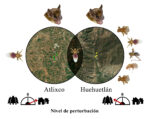Pattern of bat-ectoparasite interaction in the state of Sergipe, Brazil: an ecological networks approach
Rayanna Hellem Santos Bezerra, Adriana BocchiglieriInteraction networks can help understand how species are connected and the implications of these interactions for the ecosystem. This study aimed to identify the pattern of interaction between bats and ectoparasites in Sergipe and calculate the metrics of connectance, specialization, nesting, modularity, and centrality. This study was conducted based on host-parasite relationship data recorded in Sergipe and reported in previous studies. Connectance and specialization (H2′) were calculated using the “networklevel” and “specieslevel” functions, respectively. The NODF and QuanBiMo (Q) metrics were used to determine nesting and modularity, respectively. For centrality, relative degree (Kr), closeness centrality (CC), and betweenness centrality (BC) were determined. The connectance value (0.11) was considered high. H2′ was 0, and the complementary specialization (d’) values ranged from 0 to 1. The nesting and modularity values were 15.95 and 0.58, respectively. The highest Kr value was observed for Platyrrhinus lineatus. The highest CC value was observed for Artibeus planirostris. The highest BC values were recorded for A. planirostris and P. lineatus. High modularity, low nesting, and low connectivity have been frequently reported for antagonistic interactions, which may be due to the high specificity indices of these interactions. In this study, although the modularity value was significant, specialization was low, suggesting that the studied network has a composite topology. Thus, this study provides relevant information on the subject, highlighting the need for more studies to help understand the topology of networks.
Padrão de interação morcego-ectoparasito em áreas do nordeste do Brasil: uma abordagem de redes ecológicas. Redes de interação podem auxiliar na compreensão de como as espécies estão conectadas e as implicações dessas interações para o ecossistema. Esse estudo teve como objetivos identificar o padrão de interação entre morcegos e ectoparasitos em Sergipe e calcular as métricas de conectância, especialização, aninhamento, modularidade e centralidade. Esse estudo foi realizado a partir de dados da relação hospedeiro-parasito relatados em artigos científicos para Sergipe. A conectância e especialização (H2′) foram calculadas utilizando a função “networklevel” e “specieslevel”. Para o aninhamento, foi utilizada a métrica NODF. Para a modularidade foi utilizado o QuanBiMo (Q). Para a centralidade foi utilizado o relative degree (Kr), closeness centrality (CC) e betweenness centrality (BC). A conectância (0,11) foi considerada alta. O H2′ foi 0 e os valores de especialização complementar (d’) variaram de 0 a 1. O aninhamento foi 15,95 e a modularidade 0,58. Para a centralidade, o maior valor de Kr correspondeu a Platyrrhinus lineatus. Para a CC, o maior valor foi para Artibeus planirostris. Para a BC os maiores valores foram registrados para A. planirostris e P. lineatus. Alta modularidade, baixo aninhamento e baixa conectância são frequentemente relatadas para interações antagonistas, podendo ocorrer devido ao alto índice de especificidade das interações. Nesse estudo, apesar do valor de modularidade ter sido significativo, a especialização foi baixa. Isso pode sugerir que a rede estudada possua uma topologia composta. Assim, esse trabalho traz informações relevantes a cerca do tema, evidenciando a necessidade da realização de mais estudos que auxiliem na compreensão sobre topologia de redes.

